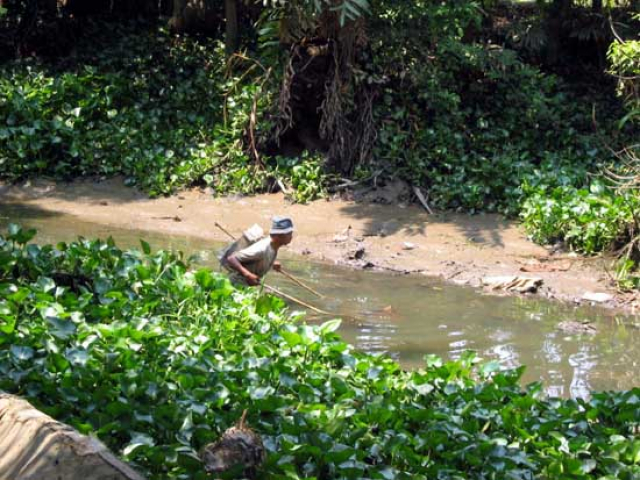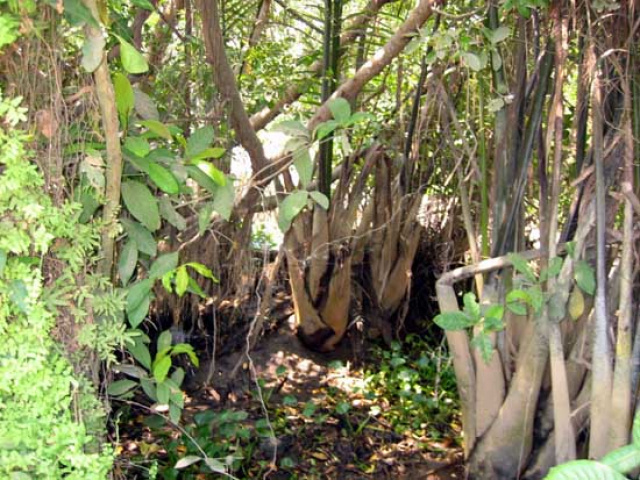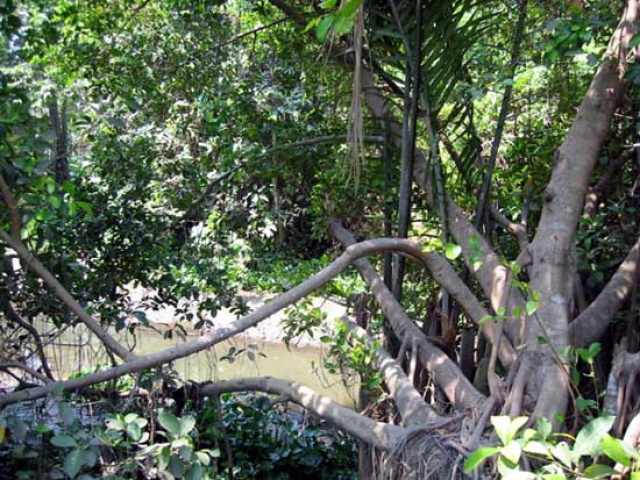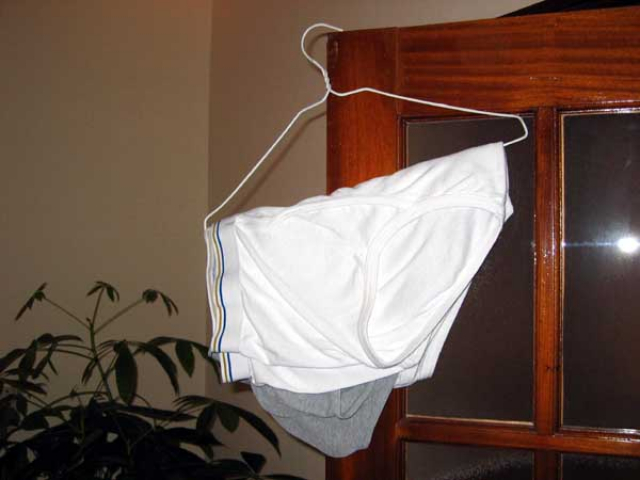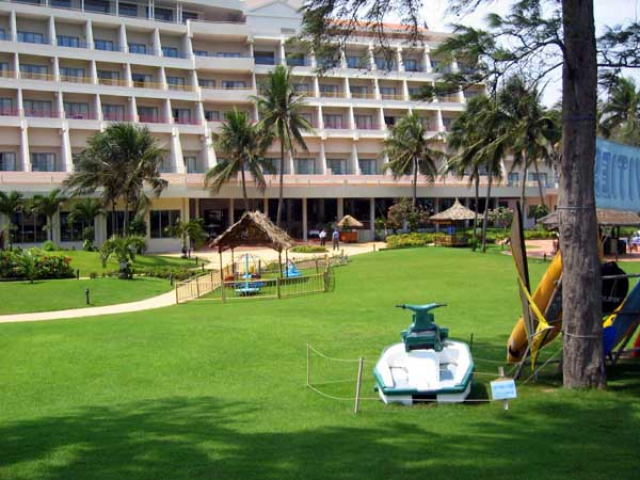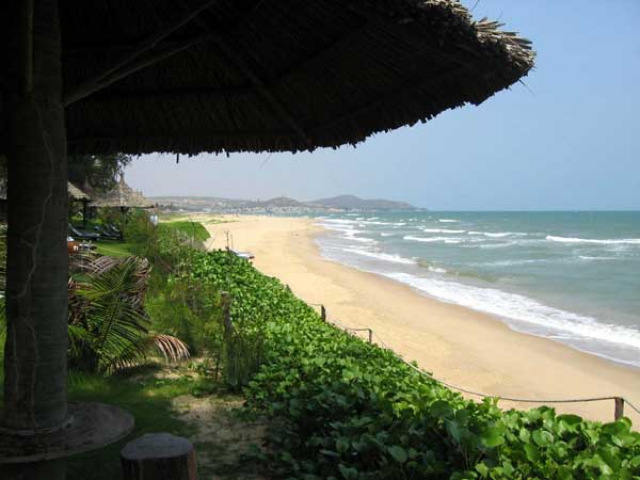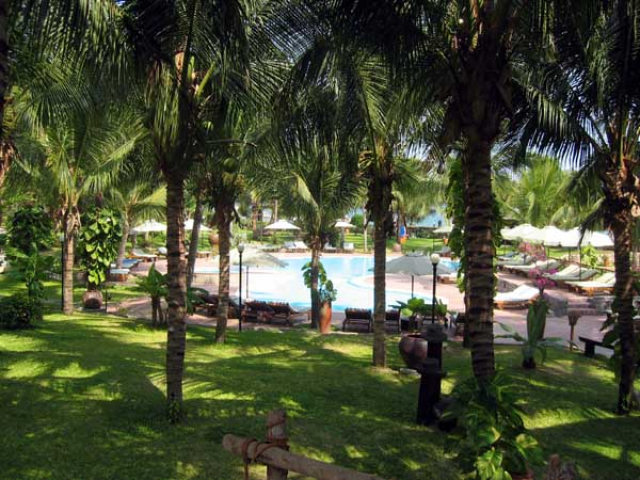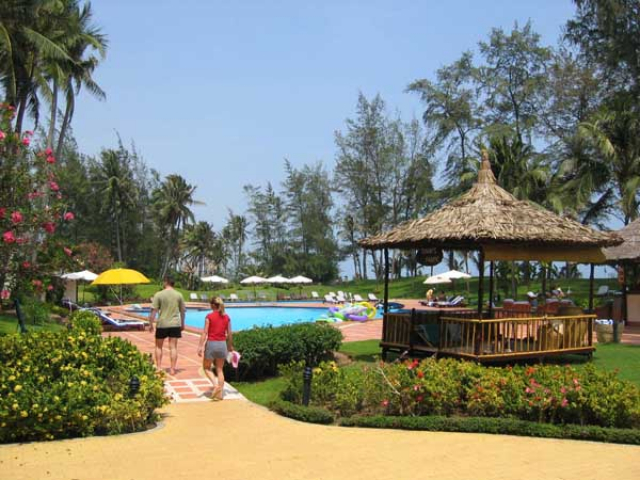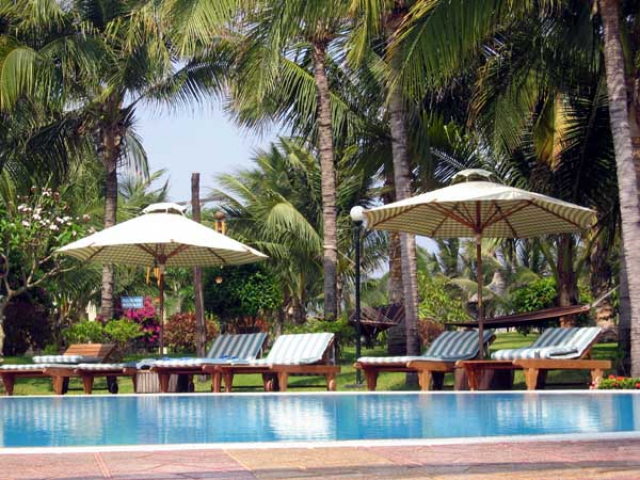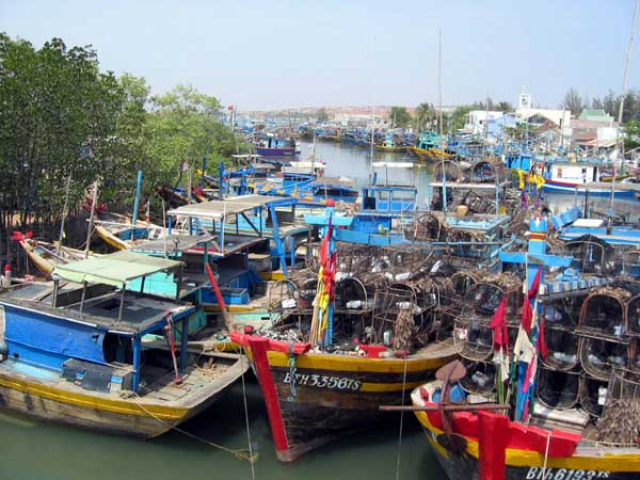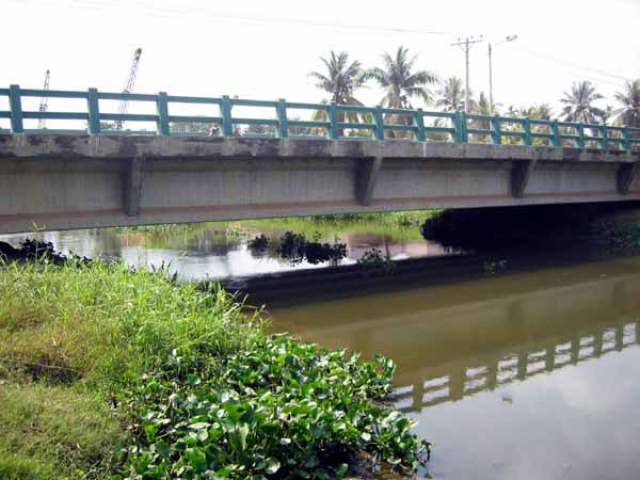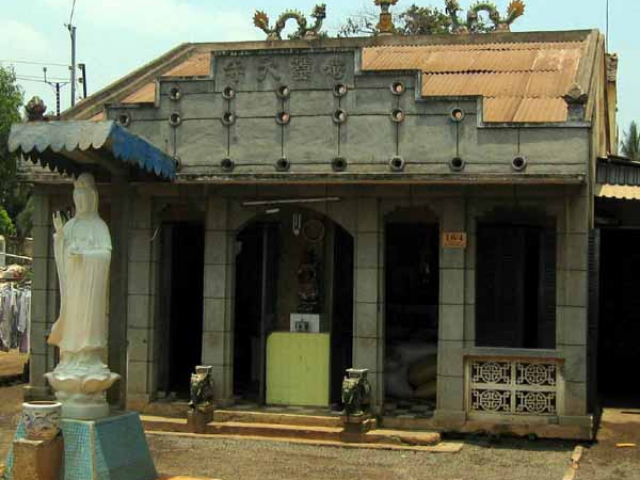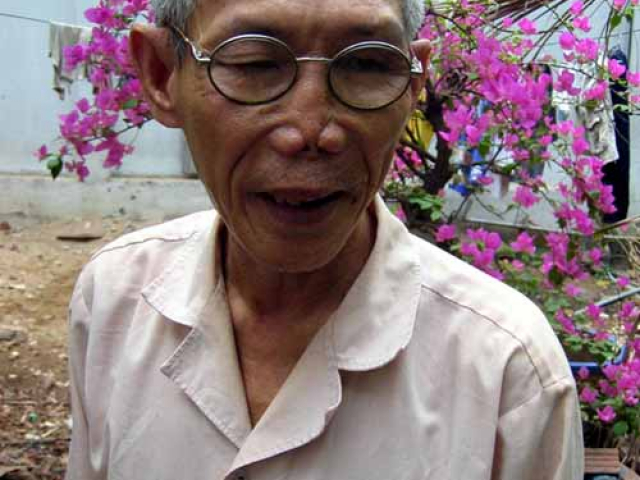Larry James Vietnam Report – 3
April 3, 2004
It's the weekend of course and like all good bureaucrats my man in the ministry is not available so I sit and wait. As I do I keep going over what I already know and what my four trips to the site have already shown me over the past couple of days.
I began trying to nail down the site of the ambush based on grid coordinates from the operations logs that Larry Mitchell matched to a map of the area. My new map from the Defense Mapping Agency matches exactly. It is not brand new however (published in 1979) and does not show anywhere near the detail I would like. It does not show, for example, what I have found out by driving the road over the past few days. There are actually five bridges between the northern outskirts of Saigon and the point where the highway (248) swings west. One of them spans the Ben Cat canal which is about 150 meters wide. Another goes across the Saigon River.
That leaves three bridges that "could" be the location that marks the northern end of the killing zone. Two of those bridges are only a few hundred meters apart and do not seem to have been inside the ambush. From all the descriptions I've heard and read, I doubt that both of those bridges were inside the killing zone; one of them, the more northerly one, maybe. The more distant and still further north bridge - the one Willy found - is almost certainly the northern boundary. This bridge must be the one spanning the body of water that separated Charlie and Delta Companies.
Telling the story of the physical layout of the ambush site has required piecing together the recollections of those who were there along with the official documentation. Some of the recollections are quite detailed others less so. Fortunately the official record of the event, while quite sketchy in many respects, does draw a picture of the place if you take the time to piece together the descriptions that are in the interviews the division historian conducted in the few days immediately after the event.
Right now I'm in the process of matching what I have already put together with those things that still remain on the ground - and there are some. The old bridge foundation helps as does the existence of the small collection of buildings that I'm fairly certain must have been the ARVN compound. As I looked at those building the past several days and saw how close they were to the ambush, I couldn't help but wonder if things might have turned out differently had the South Vietnamese troops garrisoned there intervened. It might not have made a difference but you never know.
My biggest hope is that I find some Vietnamese who were there. They may have many answers to the questions we have been asking ourselves all these years. Maybe they can even say why the ARVN stayed home. There are still blanks in the story of course and I hope to fill them as well as I can through interviews with the VC who were there. But I also have major doubts about how forthcoming they are going to be, even IF I find any of them. Despite the opening up that Vietnam has been undertaking in the past decade or so, it remains a very closed society with tight government controls; something we learned when the five of us Manchus who tried to deliver medicines and toys to children at a school in Tay Ninh province during the 2000 trip. The school we approached was dirt poor but the head teacher said they could not accept anything without the permission of the local authorities. Same-same regarding my interviews. Someone from the Foreign Ministry and, no doubt, a few local officials will be present during the Q&A's I do but that cannot be helped.
It's worth mentioning again that the tidal fluctuation is huge. The canal almost dries out at low tide and is at least 6-8 feet deep at high water. Even the very large Ben Cat canal dries out significantly leaving a very narrow channel on the southern side of it that is still navigable by the shallow draft boats that use it. Even they draw no more than about 3 feet so we're not talking a lot of water at low tide.
I took a picture of what I am considering the northern boundary bridge at low tide and plan a similar one at high tide to illustrate what an important tactical situation the tidal fluctuation created. Whether the VC took the tide into account or not in their tactics, it clearly made a huge difference to those guys in Delta Company who were trying to cross the canal and came to Charlie Company's aid. It is just one factor but an important piece of the puzzle.
Many questions. Let's hope I can find some answers.
Larry
Pictures are of the mangroves and dense vegetation lining the canal as well as a fisherman seining the outrushing ebb tibe.
Sunday, April 04, 2004
So here's the deal.
Enough of these diary entries that are solely focused on work for awhile. I did spend some productive hours in the field today but I also saw some of the city and decided it's time to talk about what life is like in Saigon, er, Ho Chi Minh City, er Saigon. You'll have to forgive the confusion but you see there are as many things here in Ho Chi Minh City labeled Saigon as there are things labeled HCMC. But that's not the subject of this diary entry. Let's talk underwear -- or actually Terry Thompson's underwear - and mine too.
I've got a picture of my underwear somewhere on this page. Freshly laundered, ironed and neatly folded on a hangar and hung in my closet. By now this is getting to be old hat for me but the first time it happened it happened to Terry Thompson during our first trip here in 2000. Turns out Terry is pretty particular about his u-trou but even he was impressed with the service here at the Spring Hotel and went home to Mrs. Terry with a tale about the many virtues of washing, ironing and folding underwear on a hangar. I've yet to hear a detailed update on how Terry's request has taken shape in Pennsylvania but I do understand that the response from Mrs. T was, in fact, "quite firm."
For myself, I have nothing but admiration for the laundry ladies at the Spring Hotel and their very high standards. Unlike Terry, however, I will have no suggestions for underwear, um, treatment for Sonja when I get home. (By the way, I understand none of Terry's injuries were life threatening.)
Instead I will focus on the swift mastery of the Vietnamese language which has come to me in just a few short days. Back when we were here with the Manchus nearly four decades ago, I'm afraid language study got rather short shrift and we made do with bastardized versions of French words and smatterings of what we thought were Vietnamese phrases. At the time they seemed to communicate real well; but then again people tend to pay close attention when you are armed to the teeth. These days, however I have found little need to scream Dung Lai (STOP) at the top of my lungs. Nor have I found it necessary to tell anyone to Di Di Mau (get out of here, NOW). Xin Loi (Excuse me, or, sorry) has come in handy as I found that my imagined pronunciation of Vietnamese falls considerably short of the mark.
For example, during my entire tour here I thought the 25th Division had one of its three base camps at a place called Dau Tieng - pronounced so effortlessly by yours truly as DOW TEE-YANG. Such references to this relatively well known town are greeted only with polite but blank stares these days. Scribbling the words out on paper the light goes on for my audiences who smiling inform me that it is Dau Tieng - ZOW-TYENG. Go Vap, the sprawling neighborhood on the northern edge of Saigon, er, Ho Chi Minh City is not Go Vap at all. It is Go Vap - GO YAP or YOP. Even my deft pronunciation of Hoc Mon is not it either. It is not Hoc Mon - as in HOCK MON (like a man from Jamaica) - rather it is Hoc Mon - HOKE MONG.
If I haven't lost you yet, read on.
You may be interested to know about the one traffic law that seems to exist here. This is the UNIVERSAL AND ONLY TRAFFIC LAW. It is the only one you will ever see observed. It is simplicity itself: YOU MAY NOT HIT ANYONE FROM BEHIND. If you do then it is your fault no matter what. Driving along at 60 miles an hour and sometime pulls out in front of you? You stop, there are no ifs and or buts.
Hard to believe that that is all it takes to control traffic in a big city but that is is. How this translates into action is a bit unnerving the first few times your driver wheels out into the crush of traffic directly in front of an onrushing horde of 10-ton trucks and a gazillion motorbikes without once even GLANCING in their direction. They tell me you get used to it. In my case I just make sure we stop off at the Duty Free Shop near the hotel to top off on my "tranquilizers" before we start mixing it up each day.
So, where was I? Ah yes, exploring Saigon. I wanted to see Cho Lon - (not CHOE LAWN like I thought but CHOW LONG ) - so off we went. My driver who like me has a knack for languages and has managed to master English every bit as well as I have mastered Vietnamese in the past four days, took me away. Not wanting to disturb my savoring of the traffic experience he kept silent until that gleeful moment when he joyously pointed out that we had crossed from that part of the city known as District 1 to the adjoining District 5. Neither of us bothered too much about 2, 3 and 4. They'll show up if we need them, I'm sure, just not in the vicinity of 1 and 5 it seems.
Next thing I knew we were in China Town which is what Cho Lon (CHOW LONG) is. Actually, the name I discovered means Old Market, or, since the Vietnamese like to put the adjectives after the nouns - Market Old. Is this CHOW LONG, I asked, carefully intoning each syllable. "Yes," the driver said. "See how everything looks Chinese?"
Well, it would take a finer eye than mine to pick up the difference. I thought I was in for quite a disappointment until as we waited in one of the many traffic "experiences" that give a visit here that quaint feel, I was able, through the use of the telephoto function on my camera, to make out what surely must have been Chinese characters about 2 millimeters high on the front of a store. Chinatown, we are here! I exulted.
CHOW LONG, it turns out, is amazing. It is a seemingly never ending collection of separate and unique markets. CHOW GA, chicken market, CHOW SOI CON LAM, fabric market, and the list goes on - inner tube market, cheap Chinese wrench market, plastic toilet bowl brush market, the list seems endless. No trip to Saigon would be complete without a visit to CHOW LONG and its many markets.
Now, I don't want to give the impression that I was not impressed. I really was. There is something exotic and actually quite fun about visiting the area. People are busy doing every day life in CHOW LONG and a visit there gives you a wonderful snapshot of life in Vietnam.
There is also a really interesting fruit and vegetable market that is set up on the banks of a canal with an American connection. Seems like this canal had silted in very badly and was no longer navigable even for the shallow draft boats that ply the rivers and canals of Vietnam. U.S. Army Corps of Engineers to the rescue. Last year (not EXACTLY sure of the date - my driver tried to explain but I was too excited about our recent visit to the plastic toilet bowl brush market - I may have got it wrong) came in with a big hand, shaped like a claw that went through the water and took out all the old muck that had clogged the canal. They were, as the sergeant in Saving Private Ryan said when the Bangalore Torpedo blew a hole in the German wire, "back in business."
Well, I've rambled on too long and too incoherently Dear Diary so I'll end it for now.
Tomorrow's another day and my man at the ministry is dying to hear from me.
Larry
Monday, April 05, 2004
Not a lot to add today. No action from the ministry man so I head north a couple hundred klicks to the seaside town of Phan Tiet. An American I met here is building a hotel up there on a Nick Faldo designed golf course so I thought I'd take a look at the area. It is beautiful.
Here are a couple of shots from the Novotel Coralia Resort and a place called the Saigon Mui Ne Resort.
Prices are in the $100 a night range and provide wonderful amenities. Really nice and, for me, totally unexpected.
Larry
Wednesday, April 07, 2004
There has been some progress in the past 48 hours.
I received confirmation that the building I believed to be Colonel Henchman's CP on March 1, 1968 was, in fact, the location where he set up that night. At the time it was painted white, not as it appears in the picture. Confirming its location makes the rest of the pieces of the puzzle fit and I believe I am as confident as I will ever be that the exact location of the ambush has now been confirmed.
The reason I say that is because the colonel was coordinating with his artillery liaison officer behind that small building when the ambush was sprung. He ran out to the road to try to see what was going on was able to see the approaches to the bridge and the bodies of several Manchus lying on it. You can see the bridge from the road in front of the building in the picture. I paced off the distance and estimate it to be approximately 300 meters from the first, northernmost boundary of the ambush to the small building that was the battalion CP just as the grid coordinates from the battalion journal say.
Almost directly across the street from that location is the home of Mrs. Tran Thi Mui, 65, who has lived there continuously since 1960. She was not able to shed much light on what happened the day of the ambush as she and most of the other local residents had fled the area a month earlier when the Tet Offensive began. Similar stories were recounted by other old time residents, 86-year-old Tran Van Nhanh said the intensity of the fighting in the area made it almost impossible for them to stay. No one I spoke to knew of any former VC still in the area. Most, they said, had died in the war. Nguyen Van Het said he would have been a Viet Cong fighter but the wounds he suffered when his Viet Minh commando squad was ambushed by the French in 1954 at the nearby Phou Long bridge over the Saigon had left him crippled and unable to run.
Trung Van Meo, 65, who had been a driver in the South Vietnamese Army (ARVN) told me he knew of one VC commander still living nearby. He had told me the same story when I met him four years ago. Willy has a picture of him on the Manchu website, taken when the five of us took a walk along the southernmost canal (canal 12) back in 2000. The bad news, and there is more than just one bit, is that nearby is not all that nearby, about a 2-hour drive and we will still need permission from the local People's Committee to talk to former command Hoang Dao assuming we can find him. We don't have an exact address but he is said to live in Binh Phouc and commanded a VC unit know as 375. Whether he has any information that will be helpful is a big question mark but I did learn from the half dozen interviews I did today that there is a good possibility that the VC who carried out the ambush were not local. I was told that a local group of VC, some 200 men, had been wiped out in a major fight with the Americans in early February. I will try to confirm this in more detail. I do know that the 3/4 Cav fought a pitched battle there at about that time.
It could be, therefore, the VC who fought the Manchus there were not local at all.
I had always heard, and almost everyone Manchu I interviewed, believed the VC to be a group known as the Go Mon battalion. There are a few references to that unit on vet websites, in particular, a small suicide squad from the 4th Go Mon that is said to have taken part in the attack on the US Embassy the first day of the Tet Offensive. None of the locals I spoke to here have been familiar with the group although Mr. Meo, the former ARVN, pointed out that the name Go Mon derives from a combination of the name of the Saigon District Go Vap, and the nearby district of Hoc Mon. GO from Go Vap and MON from Hoc Mon. For a brief time after the war the Hoc Mon district was renamed Go Mon but the name change did not last long and the two districts were never merged into one although there apparently had been a decades long effort by the communists to do so. What all this could mean, and I stress could, is that the recruiting for the Go Mon battalions could have been over a much broader area than just in the immediate vicinity of the ambush. That's both good and bad news. Good in that just because I haven't found any former VC near the ambush site doesn't mean that I won't find them elsewhere. The bad news is that "elsewhere" may cover a lot of ground and will make for a much larger hay stack to find the needles in.
Additional information:
Mr. Meo, the former ARVN, says there were two ARVN outposts, in the ambush killing zone -- one at each bridge. He said each was normally manned by a squad of 12. But he stressed he was not present and did not know if they were manned at all during the time the Manchus were there.
My visit today coincided with high tide so you can get an idea from the picture how difficult it would have been for anyone to get across the northern most canal to come to Charlie Company's aid.
Number 2 is busy trying to nail down an address for VC Commander Hoang Dao, nicknamed 4-Iron (four for his place in the family as 3rd son, and Iron for his strength and determination). Stay tuned.
Larry
Thursday, April 08, 2004
How to begin?
I met Nguyen Phi today in a small restaurant just a little north of the intersection of the two main roads just north of the ambush site. He is the former intelligence officer who served with the Quyet Thang (Determined to Win) Company of the 2nd Go Mon Battalion of the 316th Regiment of the People's Army of Vietnam. Nguyen Phi was there the day Charlie Company was ambushed. He said he was not involved directly in the fighting since it was his job to observe the Americans and report back what he had seen. He did come to the scene at about 8 p.m. that night after the fighting had ended and said he was able to crawl up to the road where he saw some American soldiers. Nguyen Phi said he thought they were sleeping until he saw the blood. He said he did not stay long fearing the Americans might catch him so he made his way back west into the area the VC had their camps, a region called the "Red Beetle Military Zone" which is just west of the ambush site.
There is much more to his story that will need verification but his accounting of what happened is very similar to what I have learned about the ambush so far from the Charlie Company survivors.
He also confirmed the location of the ambush site. We drove down the road and, with no prompting from me, told the driver to stop. We got out and he gestured to the spot on the side of the road where he crawled up to get an assessment of how bad the damage was that his comrades had inflicted and saw the American bodies. It was no more than 50 meters north of the bridge that Willy had identified back in 1998.
Notes: -- It seems the VC did not refer to themselves as the Go Mon battalion, going instead by their nickname of The Otters. They were three companies, of about 30 men each (Phi says there were five or six women in his company) in the 2nd Battalion. In other words what we called the Go Mon battalion was actually one of several Go Mon battalions.
Phi explained to me that it was a mixed group of VC and NVA that had, in fact, been formed that way. NVA officers had moved into the area as early as 1965 to recruit, train and equip a VC force. One of the men sent from Hanoi to do that was Nguyen Dinh Vanh. He served as deputy commander of the Quyet Thang (Determined to Win) Company that Phi served with. Vanh is credited for having designed and carried out the ambush of Charlie Company. He died last Friday and was buried two days ago. I wish I had gotten to him sooner. I did meet with his family members and learned some of what happened from the tales he had told his son, 26-year-old Nguyen Dinh Khanh. Mr. Khanh said his fathere had been recognized as a great hero as a result of the March 2nd Ambush. He was also one of 12 survivors of the 2nd Battalion who were surrounded and destroyed later in 1968.
Nguyen Phi was captured by the Americans in that fighting. He explained to me that he is, in fact, the only member of the Determined to Win Company to have survived the war. After being taken prisoner he was given the chance to serve with the South Vietnamese Army. Strange as it may seem, he did that and served the remainder of the war as an ARVN. He was severely wounded later as an ARVN soldier in a 1969 battle in Long Binh. He lives with his wife, two sons and quite a few dogs in his combination restaurant and home less than a half a mile from the ambush site.
Before I left I asked Nguyen Phi what he would say if he had the chance to meet with some of the American soldiers. He answered rather quickly "The days of those life and death issues are past. It is time to forget them. I have no bad feelings for the Americans." I pressed further explaining that I meant what would he say to the survivors of the Charlie Company Ambush. He paused, looked off into the distance and said. "I would wish them good health and for their families too. We are lucky to be alive. We are lucky to be here. We must cherish life and peace."
There is one more former VC I hope to visit tomorrow.
Larry

